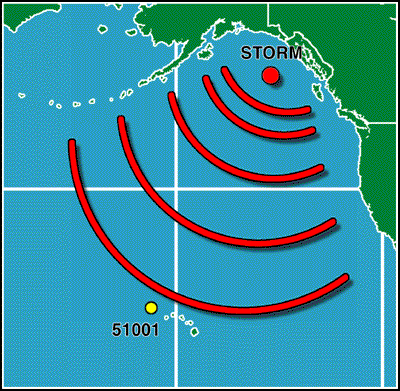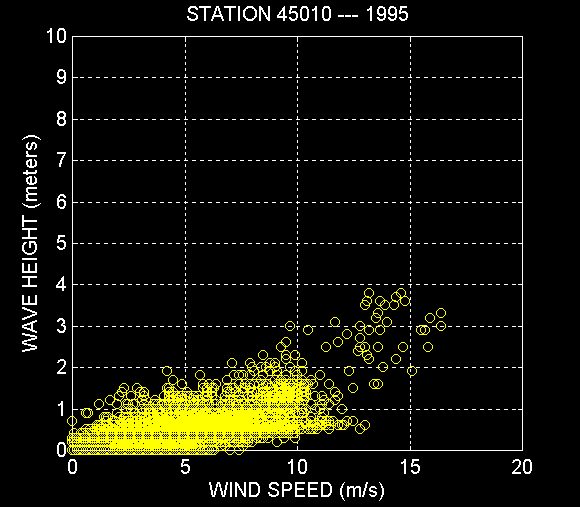Why isn't there a linear relationship between wind speed and wave height?
 First, we know from the previous question that wind causes ocean waves. Next, we
have to look at how waves travel across the ocean. The easiest way to do this is
to imagine we are at a pond. We throw a rock into the middle of the pond. What
do we see happening to the water surface? We see many "ripples" in the water surface
travelling away from the location where the rock landed. Well, this is similar to
what happens when the wind generates wind-waves.
First, we know from the previous question that wind causes ocean waves. Next, we
have to look at how waves travel across the ocean. The easiest way to do this is
to imagine we are at a pond. We throw a rock into the middle of the pond. What
do we see happening to the water surface? We see many "ripples" in the water surface
travelling away from the location where the rock landed. Well, this is similar to
what happens when the wind generates wind-waves.
Suppose a storm is situated in the Pacific Ocean south of Alaska. In a storm, the wind blows on the water and creates a "confused sea". By this we mean that there is not any particular direction that the waves are coming from. However, as the wind continues to blow and the waves increase in energy and begin to move faster than the storm, the waves begin to leave the general area of the storm. This is similar to the way in which the ripples caused by the rock landing in the pond travel away from the rock's impact location and move towards the shore. In the case of the storm, the waves that travel long distances away from the storm are called swell waves. A group of these waves together is called a wave train. These wave trains travel away from the storm's center. The distance of travel is influenced by the amount of energy they receive from the wind. It is common for waves generated by a storm near Alaska to travel to the Hawaiian Islands and beyond!!
The wave heights that are being measured onboard station 51001 include heights from swell waves which were generated by winds elsewhere. However, the wind speeds that are in our graph are the local winds, i.e., those winds in the vicinity of station 51001. The wind and wave relationship is not linear because the measured wind speeds are generated locally, but the wave heights include waves generated from almost anywhere!

On the other hand, let's look at a graph of wind speeds and wave heights from a buoy in Lake Michigan. As is evident, the scatter is not as drastic as with the data from the Pacific Ocean. This is because Lake Michigan is a smaller, enclosed body of water. Swell waves do not occur on such a large scale in small, enclosed bodies of water as it does in the larger, open oceans.
Return to Science Education Home



